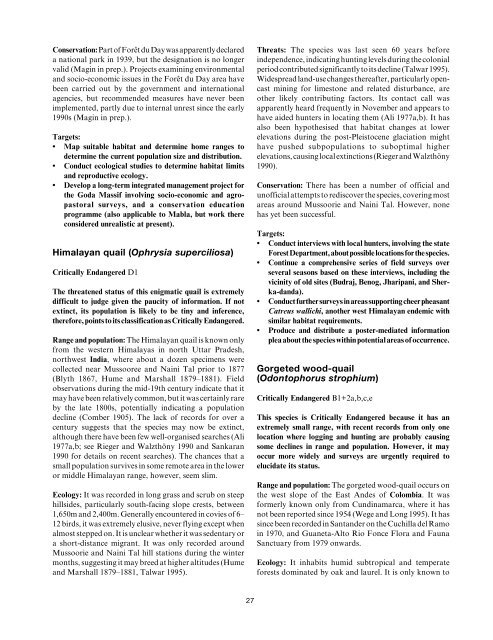Partridges, Quails, Francolins, Snowcocks, Guineafowl, and Turkeys
Partridges, Quails, Francolins, Snowcocks, Guineafowl, and Turkeys
Partridges, Quails, Francolins, Snowcocks, Guineafowl, and Turkeys
Create successful ePaper yourself
Turn your PDF publications into a flip-book with our unique Google optimized e-Paper software.
Conservation: Part of Forêt du Day was apparently declared<br />
a national park in 1939, but the designation is no longer<br />
valid (Magin in prep.). Projects examining environmental<br />
<strong>and</strong> socio-economic issues in the Forêt du Day area have<br />
been carried out by the government <strong>and</strong> international<br />
agencies, but recommended measures have never been<br />
implemented, partly due to internal unrest since the early<br />
1990s (Magin in prep.).<br />
Targets:<br />
• Map suitable habitat <strong>and</strong> determine home ranges to<br />
determine the current population size <strong>and</strong> distribution.<br />
• Conduct ecological studies to determine habitat limits<br />
<strong>and</strong> reproductive ecology.<br />
• Develop a long-term integrated management project for<br />
the Goda Massif involving socio-economic <strong>and</strong> agropastoral<br />
surveys, <strong>and</strong> a conservation education<br />
programme (also applicable to Mabla, but work there<br />
considered unrealistic at present).<br />
Himalayan quail (Ophrysia superciliosa)<br />
Critically Endangered D1<br />
The threatened status of this enigmatic quail is extremely<br />
difficult to judge given the paucity of information. If not<br />
extinct, its population is likely to be tiny <strong>and</strong> inference,<br />
therefore, points to its classification as Critically Endangered.<br />
Range <strong>and</strong> population: The Himalayan quail is known only<br />
from the western Himalayas in north Uttar Pradesh,<br />
northwest India, where about a dozen specimens were<br />
collected near Mussooree <strong>and</strong> Naini Tal prior to 1877<br />
(Blyth 1867, Hume <strong>and</strong> Marshall 1879–1881). Field<br />
observations during the mid-19th century indicate that it<br />
may have been relatively common, but it was certainly rare<br />
by the late 1800s, potentially indicating a population<br />
decline (Comber 1905). The lack of records for over a<br />
century suggests that the species may now be extinct,<br />
although there have been few well-organised searches (Ali<br />
1977a,b; see Rieger <strong>and</strong> Walzthöny 1990 <strong>and</strong> Sankaran<br />
1990 for details on recent searches). The chances that a<br />
small population survives in some remote area in the lower<br />
or middle Himalayan range, however, seem slim.<br />
Ecology: It was recorded in long grass <strong>and</strong> scrub on steep<br />
hillsides, particularly south-facing slope crests, between<br />
1,650m <strong>and</strong> 2,400m. Generally encountered in covies of 6–<br />
12 birds, it was extremely elusive, never flying except when<br />
almost stepped on. It is unclear whether it was sedentary or<br />
a short-distance migrant. It was only recorded around<br />
Mussoorie <strong>and</strong> Naini Tal hill stations during the winter<br />
months, suggesting it may breed at higher altitudes (Hume<br />
<strong>and</strong> Marshall 1879–1881, Talwar 1995).<br />
Threats: The species was last seen 60 years before<br />
independence, indicating hunting levels during the colonial<br />
period contributed significantly to its decline (Talwar 1995).<br />
Widespread l<strong>and</strong>-use changes thereafter, particularly opencast<br />
mining for limestone <strong>and</strong> related disturbance, are<br />
other likely contributing factors. Its contact call was<br />
apparently heard frequently in November <strong>and</strong> appears to<br />
have aided hunters in locating them (Ali 1977a,b). It has<br />
also been hypothesised that habitat changes at lower<br />
elevations during the post-Pleistocene glaciation might<br />
have pushed subpopulations to suboptimal higher<br />
elevations, causing local extinctions (Rieger <strong>and</strong> Walzthöny<br />
1990).<br />
Conservation: There has been a number of official <strong>and</strong><br />
unofficial attempts to rediscover the species, covering most<br />
areas around Mussoorie <strong>and</strong> Naini Tal. However, none<br />
has yet been successful.<br />
Targets:<br />
• Conduct interviews with local hunters, involving the state<br />
Forest Department, about possible locations for the species.<br />
• Continue a comprehensive series of field surveys over<br />
several seasons based on these interviews, including the<br />
vicinity of old sites (Budraj, Benog, Jharipani, <strong>and</strong> Sherka-d<strong>and</strong>a).<br />
• Conduct further surveys in areas supporting cheer pheasant<br />
Catreus wallichi, another west Himalayan endemic with<br />
similar habitat requirements.<br />
• Produce <strong>and</strong> distribute a poster-mediated information<br />
plea about the species within potential areas of occurrence.<br />
Gorgeted wood-quail<br />
(Odontophorus strophium)<br />
Critically Endangered B1+2a,b,c,e<br />
This species is Critically Endangered because it has an<br />
extremely small range, with recent records from only one<br />
location where logging <strong>and</strong> hunting are probably causing<br />
some declines in range <strong>and</strong> population. However, it may<br />
occur more widely <strong>and</strong> surveys are urgently required to<br />
elucidate its status.<br />
Range <strong>and</strong> population: The gorgeted wood-quail occurs on<br />
the west slope of the East Andes of Colombia. It was<br />
formerly known only from Cundinamarca, where it has<br />
not been reported since 1954 (Wege <strong>and</strong> Long 1995). It has<br />
since been recorded in Sant<strong>and</strong>er on the Cuchilla del Ramo<br />
in 1970, <strong>and</strong> Guaneta-Alto Rio Fonce Flora <strong>and</strong> Fauna<br />
Sanctuary from 1979 onwards.<br />
Ecology: It inhabits humid subtropical <strong>and</strong> temperate<br />
forests dominated by oak <strong>and</strong> laurel. It is only known to<br />
27

















